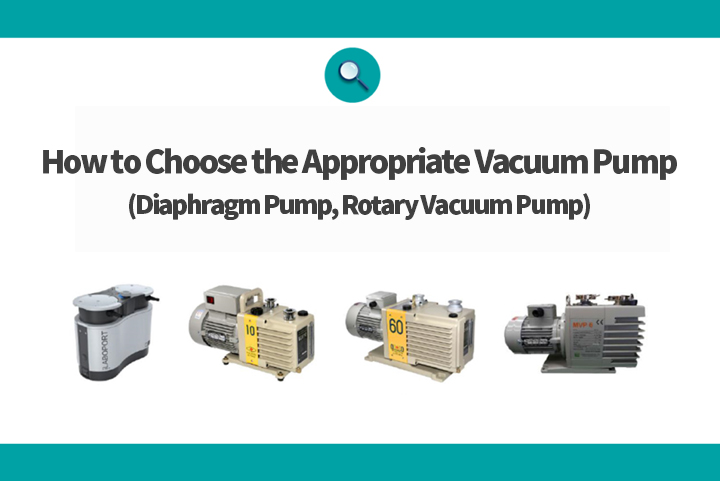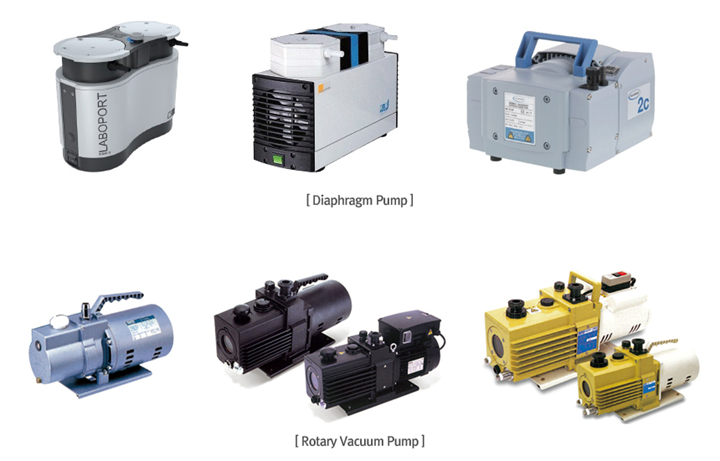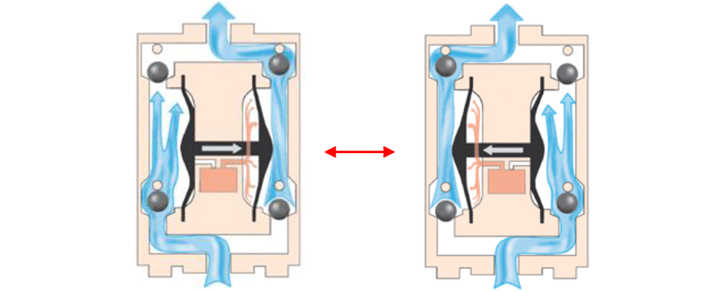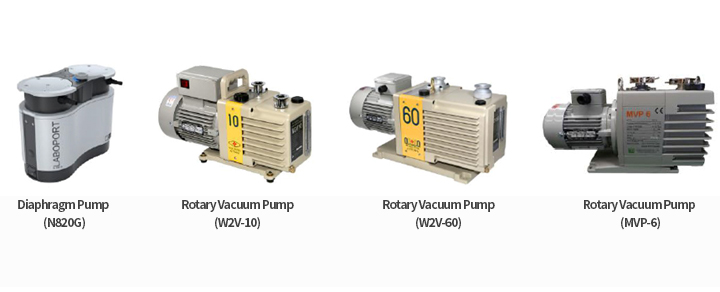
Types of Vacuum Pumps
Greetings! At JEIO TECH Lab Companion.
When using a vacuum oven or vacuum desiccator in the laboratory, a pump is essential for creating a vacuum. JEIO TECH offers two types of vacuum pumps, rotary and diaphragm, and it is important to choose the appropriate product depending on your experimental conditions.
First, let's take a look at the characteristics of each pump below.

1.Rotary Vacuum Pump
The rotary vacuum pump consists of an internal cylindrical chamber (cylinder) with an inlet for gas molecules and an outlet for expelling them. Inside the cylinder, there is oil, which serves as a lubricant, cools frictional heat, and seals the gaps in various components. The rotary vacuum pump operates through a process involving suction, isolation, compression, and exhaust, gathering gas molecules and moving them out of the pump to create a vacuum.

2.Diaphragm Pump
The diaphragm pump is a pump that creates a vacuum through reciprocating motion in both the forward and backward directions, driven by the rotation of a non-linear cam. As the diaphragm undergoes this reciprocating motion and is pushed in one direction, it exerts pressure to expel the fluid, thus forming a vacuum.

How to Choose a Vacuum Pump
When selecting a vacuum pump, there are several factors to consider, including the characteristics of the sample, purchase price, ease of use, and more. It's important to weigh these factors comprehensively in order to make the right choice. Let's delve into which pump is suitable for each consideration.
1.Sample Characteristics
| Sample Characteristics |
Vacuum Pump |
Reason |
| Samples with organic solvents and high moisture content. |
Diaphragm Pump |
Diaphragm pumps can be used independently as they do not contain any internal oil. |
| Rotary Vacuum Pump w/ Cold Trap Bath |
When vapor is introduced during the suction process of a rotary vacuum pump, the pressure inside the vacuum pump increases, leading to a performance degradation. To address this issue, it is necessary to use a Cold Trap Bath in conjunction with the pump. |
| Samples requiring moderate to high vacuum levels. |
Rotary Vacuum Pump |
A diaphragm pump can create a vacuum down to low vacuum levels, while a rotary vacuum pump is capable of forming a vacuum down to high vacuum levels. |
| Samples Requiring Rapid Vacuum Formation |
Rotary Vacuum Pump |
A rotary vacuum pump (60~600L/min) can establish a vacuum more quickly compared to a diaphragm pump (20~60L/min). |
2.Purchase Cost and Ease of Use
If the sample you are drying contains a significant amount of organic solvents or moisture, using a rotary vacuum pump may necessitate the additional use of a Cold Trap Bath. Therefore, it is essential to compare the standalone cost of the diaphragm pump with the price of the 'rotary vacuum pump + Cold Trap Bath configuration’. For samples with minimal organic solvents or moisture, it is recommended to opt for the cost-effective rotary vacuum pump.
In terms of ease of use, the rotary vacuum pump requires regular maintenance and oil checks, while the diaphragm pump is known for relatively straightforward maintenance. Please refer to the table below for a summary of the advantages and disadvantages of both pumps.
|
Rotary Vacuum Pump |
Diaphragm Pump |
| Strengths |
It is relatively affordable, capable of forming a high vacuum, and offers fast vacuum speeds. |
It does not require the use of internal oil, making maintenance relatively easy, and it does not necessitate the use of a cold trap bath. |
| Weaknesses |
It contains internal oil, which may necessitate the use of a cold trap bath, and maintenance is required. |
It is relatively expensive, capable of forming a vacuum down to low vacuum levels, but it has a slower vacuum speed. |
Example of Choosing a Vacuum Pump
Up to this point, we've explored various types of vacuum pumps and the selection criteria. The table below serves as a comprehensive guideline for recommending suitable products based on conditions such as sample type, cost, and ease of use. It provides a rough example, and when it comes to actual product purchases, our sales team is available to recommend the most suitable product for your specific needs.
| Purpose |
Types |
Recommended model |
Note |
| Samples with organic solvents and high moisture content. |
Diaphragm Pump |
N820G |
|
| Rotary Vacuum Pump w/ Cold Trap Bath |
W2V-10 |
Recommend the use of Cold Trap Bath |
| Samples requiring moderate to high vacuum levels. |
Rotary Vacuum Pump |
MVP-6 |
You can choose between MVP-12, MVP-24, and MVP-36 based on the required vacuum speed. |
| Samples requiring rapid vacuum formation. |
Rotary Vacuum Pump |
W2V-60 |
You can choose between W2V-20, 40 based on the required vacuum speed. |
| Affordable price. |
Rotary Vacuum Pump |
W2V-10 |
|
| User-convenience. |
Diaphragm Pump |
W2V-10 |
|

We will continue to strive to enhance the quality of our products and services
by listening to and reflecting on the feedback of customers through sales, services, validation, etc.
JEIO TECH is creating safer research environments through Lab Companion,
the best partner of researchers and experimenters.
|









